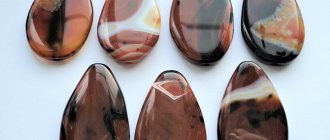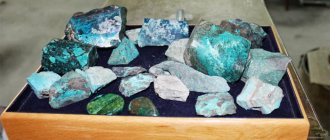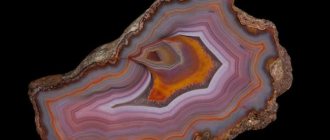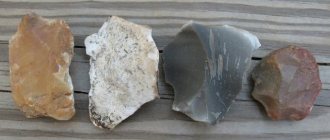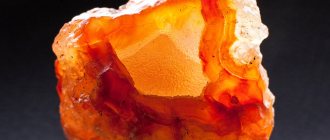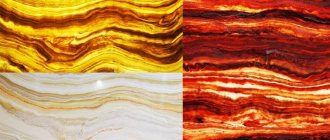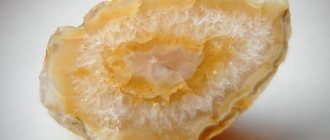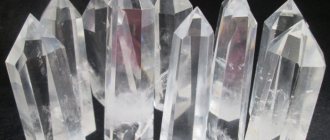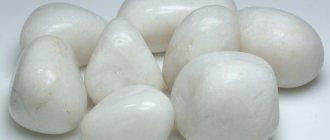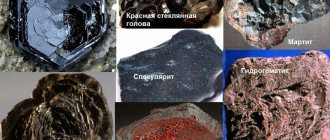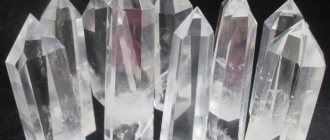History and origin
In ancient times, the skill of stone processing was highly developed. In Ancient Greece, gems were valued, imported for a long time, for the sake of whose possession wars were started. On the coast of the Sea of Marmara in the ancient Greek city of Chalcedon in Asia Minor (now part of modern Turkey), a deposit of quartz chalcedony, a wonderful stone distinguished by its richness of colors, was discovered.
The stone was named after the city where it was found.
Jewelry craftsmen made gems from chalcedony: cameos, seals, relief images on cabochons, where multi-layering and shades of the color of the stone were used.
Chalcedony stone
Glyptics is the art of carving miniature relief images on colored stones and gems: carnelian, agate, sapphirine. Stones processed in this way, with figures of people, birds and animals, allegorical images of military, religious and everyday scenes, were called gems. The image in a convex technique is a cameo, and a recessed one is an intaglio (seal).
Thanks to the color richness of chalcedony, master carvers created wonderful effects, enhancing them through inclusions and shades, tone transitions and color play.
The city of Chalcedon was destroyed by barbarians, and with the fall of the Ancient World, interest in the stone disappeared, returning to the era of classicism. Found during excavations in Roman cities, ancient gems were of historical value and works of jewelry art. High-ranking persons could allow themselves to be decorated by inserting them into a brooch, tiara or necklace.
Interest in objects of art from the ancient world did not fade away during the Empire period; European royalty had collections of glyptic works. The Hermitage collection contained thousands of cameos made by carvers of that time and from antiquity.
It is known that Napoleon had a chalcedony ring, like Byron, and Pushkin had two such rings.
Voloshin, at his dacha in the Crimea, loved to collect colorful pebbles on the sea coast; numerous guests of the Koktebel house took them away: Marina Tsvetaeva, Osip Mandelstam, Alexander Green, Andrei Bely, Alexey Tolstoy, Nikolai Gumilyov.
STRUCTURE
The structure of chalcedony is a hidden system, which “walks” from trigonal to aggregative. This makes the stone universal in its own way, but at the same time very multidirectional. The syngony is trigonal, where, depending on the arrangement of the fibers, their parallelism and perpendicularity, as well as aggregate compression, different coordination of molecules occurs, which creates various geometric complexes inside.
The crystal structure of chalcedony, like other polymorphic modifications of quartz, is characterized by the peculiarity that the Si4+ ion is always in a quadruple environment of O2- ions located at the vertices of the tetrahedron. Each vertex of such a tetrahedron simultaneously serves as the vertex of another adjacent tetrahedron. Thus, the crystal lattices of these minerals consist, as it were, of frameworks of tetrahedrons linked to each other. The method of coupling in all modifications is the same (through the vertices of tetrahedrons), but the orientation and general symmetry in their arrangement are different. In general, the packing of oxygen ions is not dense: the frameworks have “voids” between the tetrahedra. In low-temperature modifications they are small in size, and in high-temperature, more “loosely” constructed modifications they are larger.
Physicochemical characteristics
Chalcedony is a type of quartz - SiO2, close to it in its physical and chemical properties.
| Formula | SiO2 |
| Color | Blue, yellow, gray |
| Shine | Waxy, matte |
| Transparency | Cloudy, translucent |
| Hardness | 6,5—7 |
| Cleavage | Absent |
| Kink | Uneven, less often shelled |
| Density | 2.58—2.64 g/cm³ |
physical characteristics
Studying modern mineralogy, you can see that chalcedony is classified as a cryptocrystalline variety of quartz. The stone has a fibrous structure; the voids in it are replaced by silicon threads. Like tourmaline, the mineral can carry a small electrical charge.
In terms of its properties, chalcedony is almost completely identical to quartz. Its hardness reaches 7 on the Mohs scale and is resistant to acids. The mineral density is 2.6 g/cm3. Jewelers and simply connoisseurs of beautiful stones are attracted to chalcedony by its characteristic shine, reminiscent of glass or wax. The specimens turned into cabochons by specialists after processing look very beautiful.
The intensity of the blue color that appears is affected by the amount of impurities contained in the mineral. It could be:
- titanium;
- iron;
- copper;
- nickel.
Completely one-color specimens are presented on the jewelry market under the name Chalcedony, and minerals with various inclusions have separate specific names, and the price of each mineral will be set separately.
Place of extraction
Quartz is a rock-forming mineral, one of the most common in the earth’s crust; in its free form its mass fraction is 12%, in other rocks it is 60%. Chalcedony, its fine-fibered cryptocrystalline variety, is a white-yellow transparent mineral.
Chalcedony
It is formed by crystallization from volcanic rocks at temperatures of 700–1000°C or under hydrothermal influences - water and high pressures.
Due to impurities and complex geological processes in the earth's crust, chalcedony can look different, but have the same physical and chemical characteristics.
The mineral can form spherulites and spherulitic crusts with a kidney-shaped surface, continuous massifs, veins and pseudostalactites. Due to its wide distribution, it is mined all over the world. The division according to the description of chalcedony is arbitrary, and varieties of this mineral can be found even on one stone: sarder with a transition to carnelian. They can coexist in the same mine, but mainly one type of chalcedony predominates in production.
Rich deposits: in Brazil, India, USA, Uruguay, Scotland, Germany, Australia. In Russia: Transcaucasia, Chukotka, Kolyma, Primorsky Territory, Crimea (Kara-Dag), Ural. A variety of chalcedony, sapphirine, can be found on the banks and valleys of the Lena and Yenisei rivers, on the Black Sea coast, as a secondary deposit.
Place of Birth
Chalcedony is a type of quartz, which, in turn, is one of the most common minerals. Chalcedony is formed due to the crystallization process of volcanic rocks at temperatures from 700 to 1000 ° C or through hydrothermal action.
Germany is famous for its oldest deposit. In addition to this country, the mineral is mined in the following territories:
- Russia (Primorye, Eastern Siberia, Moscow region).
- Brazil.
- Islands of Madagascar.
- India.
- Australia.
- USA.
- Uruguay.
- Italy.
- Czech Republic.
- Poland.
- Scotland.
There are also mining sites in Ukraine and Transcaucasia.
Varieties and colors
Varieties of chalcedony have a bright individuality: color, properties, meaning and their own characteristics.
- Carnelian is a name of ancient Greek origin. The Latin name "carnelian", which means "dogwood berry", appeared due to its reddish color: red-brown, red-pink, yellow-red. The hue was formed due to hematite - red iron ore, sprayed with small particles. After exposure to sunlight, the density of the color of the stone changes - from shades of brown to orange. The stone is relatively inexpensive and available.
Cornelian - A variety of carnelian - sardonyx orange-red, black-red, white-brown, is highly valued and traditionally used in jewelry in carved items (eliminates fear of the future, calms). In ancient Egypt, this trefoil-shaped stone was considered a symbol of the mother goddess Isis. The carnelian amulet helped stop bleeding and protected against anger.
Carnelian stones - Sarder is reddish-brown, brown with red tints. It differs from carnelian only in shade. Pliny (1st century BC) described the technology for producing sard (an outdated term) from light chalcedony by annealing or boiling in a honey solution.
Sarder - Onyx is a ribbon chalcedony, a mineral with pronounced layering: red-brown, white with brown, black and red stripes, white with pink and yellow. There are small deposits in Chukotka, Kolyma and the Primorsky Territory on the Arabian Peninsula, India, Brazil, Uruguay, the USA, and in Russia.
Onyx - Chrysoprase is a variety of chalcedony highly valued for its color, unlike other chalcedony which is valued for its pattern or design. Nickel gave this stone a greenish or bluish-green color (usually the mineral is green due to chromium). Chrysoprase is highly valued by jewelers; depending on its characteristics, three varieties are distinguished:
- Emerald green - a rich, bright color with transparency of the stone up to 5 cm thick, homogeneous, small impurities are allowed - the highest grade.
- Emerald green chrysoprase
- Apple green, first grade, stone transparency up to 2 cm, with small opaque areas;
- Apple green chrysoprase
- Pale-colored - green-blue, yellow-green with impurities: spots, oxides and dendrites, areas with varying degrees of transparency are possible. The third grade is an ornamental stone.
- Pale colored chrysopras
Mining and processing of chrysoprase began only in the 16th century; the stone is very rare.
- Sapphirine is a bluish chalcedony of delicate shades obtained thanks to zircon (presumably). May turn pale when heated - fade.
Sapphirine - Heliotrope (bloodstone, bloody jasper) - dark green with bright red spots and stripes, looks exotic. Sometimes this variety of heliotrope is called plasma and has yellow spots. Pliny mentioned it in his works, calling it “turning with the Sun.” The mineral is valued by jewelers and collectors. The stones are used in men's rings and in the manufacture of cameos. In the Middle Ages, red splashes were given religious significance, associating them with the blood of Christ. Heliotrope was used in the manufacture of church utensils.
Heliotrope - Agate - consists of layers of different colors (the whole palette), transparency and density. Jewelers also call agate minerals that do not have a layered structure, but have a specific pattern: mossy and star-shaped. According to ancient legend, agate is the eye of a white eagle that fell to the ground after a battle with the Black Sorcerer. It is also called the Eye of the Creator, which looks at us, separating good and evil deeds.
Agate
The layering of agate gives diverse types:- Bastion - the structure of cracks and layers gives the effect of depicting a bastion - a city landscape.
Brazilian - the thinnest layers, up to 1.5 microns.
- Black, called magical.
- Mokhovaya - crystalline pattern creates branching contours.
- Star-shaped.
- Woody.
- Disk.
- Iridescent chalcedony has an optical shine effect - a blue-yellow-green iridescent metallic glow. Used for jewelry and decorative purposes.
Description and meaning of the stone
The name “chalcedony” does not belong to one specific stone, but combines several varieties of precious and semi-precious stones with an opaque and translucent structure.
Fiber stones are variations of quartz and come in different colors, patterns, textures and inclusions, but remain similar in chemical composition and physical properties.
The mineral got its name in honor of the place in Asia Minor where it was previously mined. Chalcedony also includes bluish sapphirine, bright green chrysoprase, and blood-red carnelian.
The mineral is used to create jewelry and various crafts: boxes, figurines, mosaics.
Chalcedony has amazing healing and magical properties, so it is of great importance to many experts. It symbolizes complete harmony, peace and balance.
Medicinal properties
The abilities of so many types of chalcedony cannot but differ, united by a healing effect in some areas.
Chalcedony has a calming effect, will help normalize sleep, and relieve depression.
Jewelry with chalcedony is recommended for excitable, emotional people.
- Carnelian and carnelian will ensure good health and mood, relieve toothache, give freshness to the skin, and stop bleeding.
- Sarder helps restore the skin, heals wounds and ulcers. Helps in conception.
- Onyx takes care of the internal organs, especially the kidneys and liver.
- Chrysoprase smoothes out weather dependence. By charging water with a piece of stone for 5 hours in sunlight, you can use it for illnesses.
- Sapphirine increases blood pressure and helps normalize cardiac activity.
- Heliotrope normalizes the functioning of the cardiovascular system.
- Agate - for cough, toothache.
Products made from chalcedony should not be worn constantly.
Magic properties
The element of chalcedony is Earth. Sailors took it on long journeys, and the talisman helped them return home safely.
Chalcedony beads
Even in ancient times, using the magical properties of chalcedony, women attracted the attention and love of men: the stone did not leave their hearts indifferent. Chalcedony has been called the “stone of love”, “stone of joy”, it has positive energy - it removes melancholy and depression, and disperses melancholy.
The magical characteristics of chalcedony are associated with its healing beneficial effects, but they manifest themselves only with bright thoughts and a pure soul of a person.
Bright stones are the most energetically charged, and the color vibrations of the mineral correspond to the energy and character of the owner:
- red - movement and energy, protection;
- orange - acting, talent, beauty;
- blue shades - bring order to the mind, relieve anger,
- purple - willpower;
- green - patience, self-sufficiency;
- brown - stability, balance;
- purple - magic and enchantment;
- black is a symbol of birth and death.
Unprocessed chalcedony is a good amulet that preserves happiness and mutual love in the family. Helps develop harmony in intimate relationships.
Talismans and amulets
Chalcedony Sarder
Chalcedony has long been considered the patron saint of scientists. It helps them “gnaw the granite of science,” make discoveries, analyze, remember and process information. Therefore, students and teachers, researchers, professors and other scientists should stock up on a talisman with this stone.
In Ancient Mesopotamia and Assyria, chalcedony amulets were made in cylindrical shapes and religious inscriptions were applied to them.
Chalcedony is a stone of the earth, with which it is closely connected energetically. Therefore, in ancient times, sailors tried to stock up on pebbles when setting off on long voyages. They believed that he would help them return to their native land. Today, this property of the stone is relevant for those whose work involves swimming, as well as for sea travelers.
Agate Botswana
Agates are powerful amulets for children. They protect them from falls, bruises and all kinds of injuries, as well as from the evil eye.
Single women need chalcedony to attract a soul mate. It enhances their natural magnetism so that no man can resist. The stone helps to choose “the one” for life among many applicants.
Actors should stock up on orange chalcedony. It will enhance their abilities and help them get used to the role.
Raw chalcedony, even a very small one, can become a real talisman for married couples. He will remain faithful in the family, help feelings never fade, and help spouses become good parents.
Of all the men, Sergeev especially singles out chalcedony. He will help them in absolutely all endeavors, and will also make them wiser, calmer, more patient and courageous.
Among women, the stone distinguishes the owners of the following names - Valeria (love, harmony in the family) and Oksana (joy of life, no gloomy thoughts), Inga (protection from negativity, supply of energy), Ksenia (getting rid of melancholy, desire to start a new life) and Irina (getting rid of loneliness, new love).
Who is suitable according to their zodiac sign?
Chalcedony has many faces and is suitable for everyone. You just need to find yours. A good way to do this is to consider the astrological connection between your horoscope sign and the stones.
Chalcedony bracelet
Check your intuition, is chalcedony your mineral?
| Zodiac sign | Compatibility |
| Aries | + |
| Taurus | + |
| Twins | + |
| Cancer | +++ |
| a lion | + |
| Virgo | + |
| Scales | + |
| Scorpion | + |
| Sagittarius | +++ |
| Capricorn | + |
| Aquarius | + |
| Fish | + |
(“+++” – fits perfectly, “+” – can be worn, “-” – is strictly contraindicated)
Compatibility with other stones
There is a connection between the zodiac constellations and stones, which allows you to combine stones of friendly elements and prohibits - hostile ones, taking into account the friendship of the planets. Earth is the element of chalcedony, Earth is undoubtedly friends with Air, Water and Fire are antagonists.
Combining different colored stones at the same time is not the best solution, even if it does not contradict the principles of mineralogical astrology. When choosing a stone in jewelry that gives you warmth and confidence, see if it suits your eyes, skin color, hair? Does it look nice on you? Does it harmonize with your image? Natural stone has energy that is shared with the owner, and you share yours with him.
Wear it separately from other stones. Use a sense of proportion and intuition.
Application
Chalcedony is a jewelry and ornamental stone. These minerals often come in interesting colors, sizes and shapes, with kidney-shaped and stalactite-like minerals being valuable to collectors.
Varieties of chalcedony, varying in purity, rarity and value, remain one of the most readily available materials. They are used in jewelry; cameos are made from high-quality and interesting specimens. From budget decorative and ornamental types, household products are produced: vases, tabletops, finishing tiles, mosaics.
Chalcedony beads
Products and jewelry made of chalcedony: beads, cufflinks; Due to its availability and beauty, it is used in the manufacture of figurines, furniture inlay, mosaics, and vases are made from it. Onyx is used in stained glass windows and lampshades.
Pricing when working with minerals
Jewelers consider chalcedony to be an ornamental material. Very beautiful jewelry and figurines are made from it. The prices for such products are acceptable for many and, of course, the cost of precious stones is much lower.
Chalcedony is actively used for beautiful, affordable jewelry. If it is framed in gold or silver, the cost of such a product will increase significantly. You can highlight the main prices for jewelry with this stone:
- The cost of a silver ring will vary around 5 thousand rubles. For a gold product you will need to pay 3-5 thousand more. The final cost depends on the presence or absence of additional inserts from other stones. The price of a ring with a rare type of agate will be significantly higher, it can reach 100 thousand.
- Silver earrings with such an insert can cost from about 3 thousand rubles. Gold jewelry will be much more expensive.
- A pendant with chalcedony in a silver frame costs approximately 2 thousand rubles, individual copies can have a price tag of 20 thousand rubles.
- A silver bracelet inlaid with the presented stones can cost the buyer about 5 thousand rubles or more.
Chalcedony cabochons are available in large quantities on the market. They are quite popular among buyers. Various beads and bracelets without elaborate decor can cost approximately 300-500 rubles. During the purchasing process, it is important to distinguish a fake from a real stone.
How to spot a fake
The main materials for counterfeits are glass or plastic.
Several ways to spot a fake:
- The mineral (carnelian, agate) is heavier than imitations.
- Glass and plastic are good heat conductors. Hold the stone in your hands and make sure that the chalcedony remains cool.
- Natural stone is unevenly colored, with inclusions and defects.
- Calm natural colors differ from artificial ones.
Fake carnelian on the modern market is ordinary chalcedony and agates, polished and stained with iron nitrate.
Chalcedony beads
It is possible to distinguish such an imitation only by splitting the stone, since the color extends to a depth of 1–2 mm.
How to wear and care
Some recommendations for caring for chalcedony products:
- Store separately from other stones, or wrapped for safety. The surface of chalcedony can be damaged by stones with a higher density.
- Remove before training or other activities, it is easy to scratch.
- Protect from chemicals.
- Avoid sudden temperature changes.
- Do not clean using steam or ultrasonic cleaning.
- Cleaning the stone - with soapy warm water using a cloth, remove any remaining soap.
- Chrysoprase and sapphirines should be protected from direct sunlight and high temperatures to preserve color.
